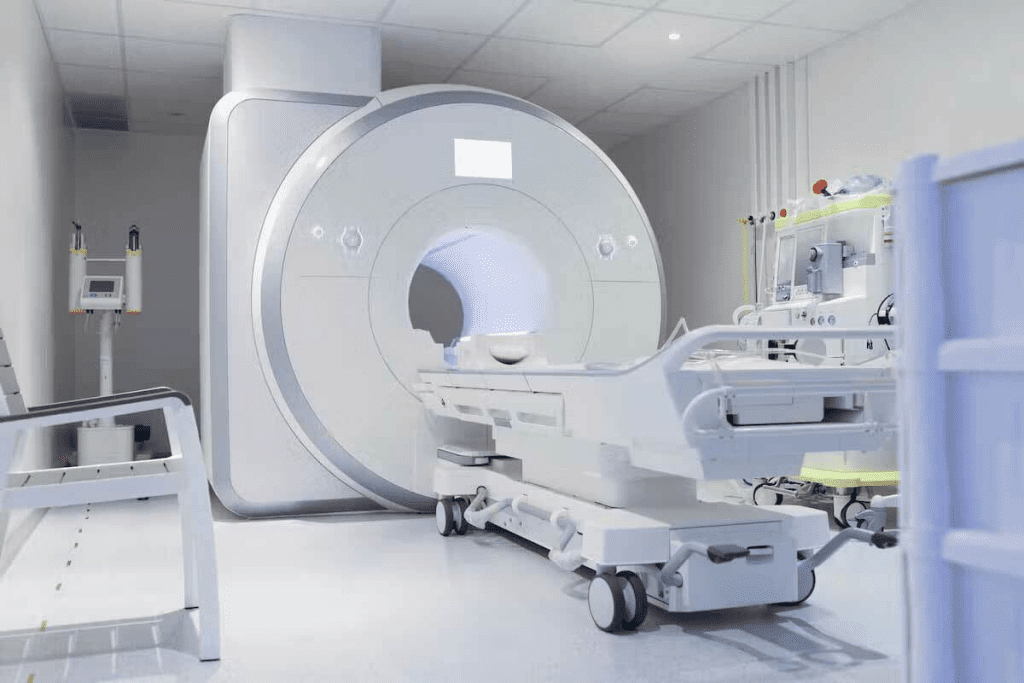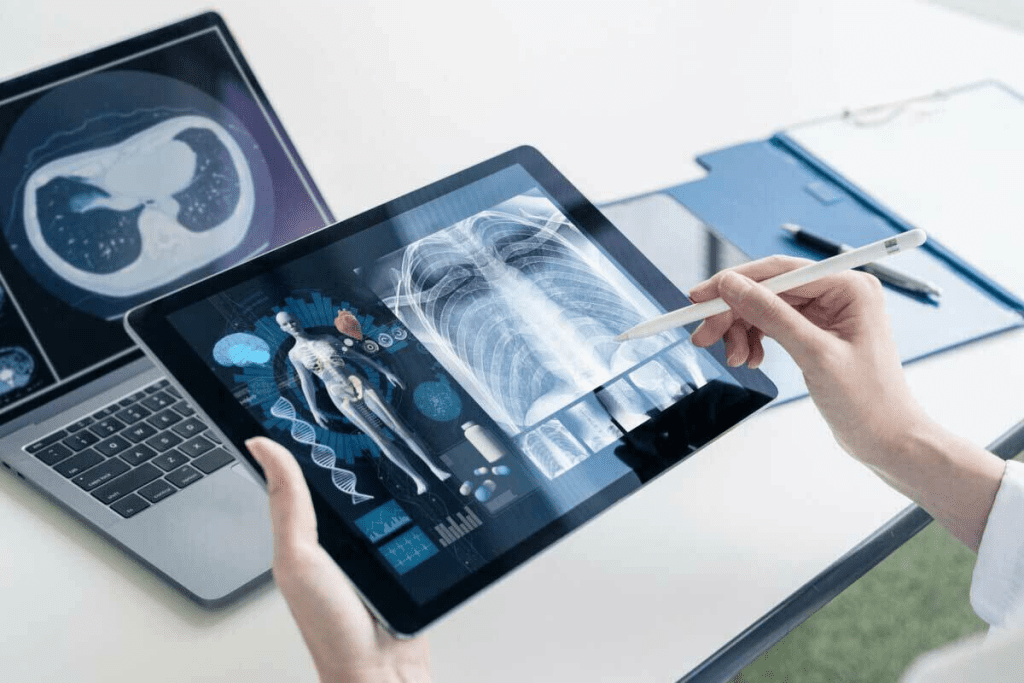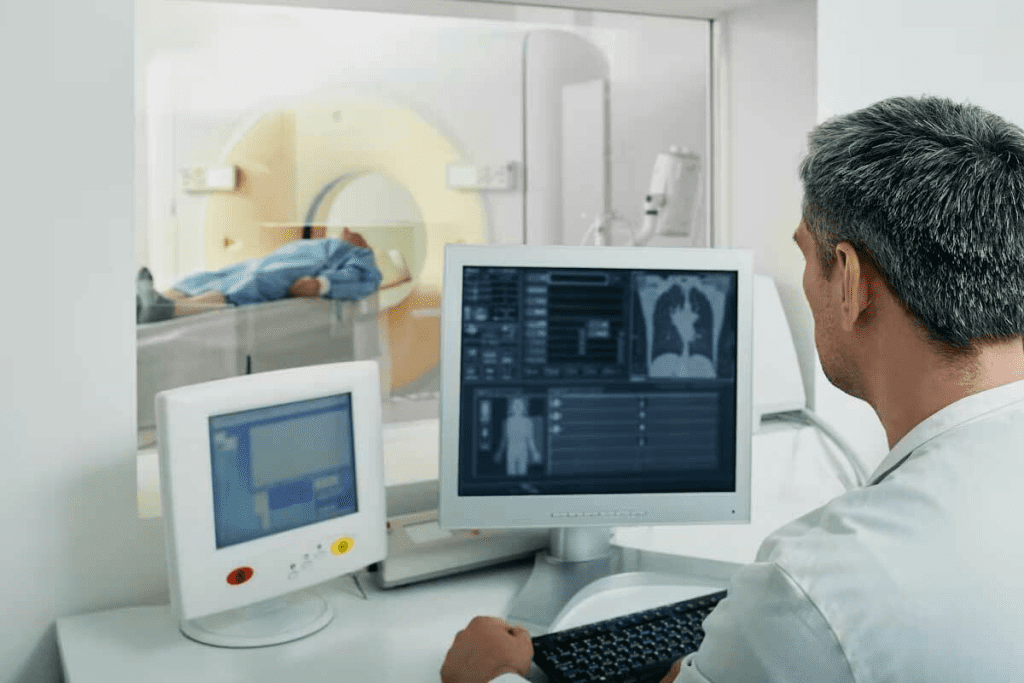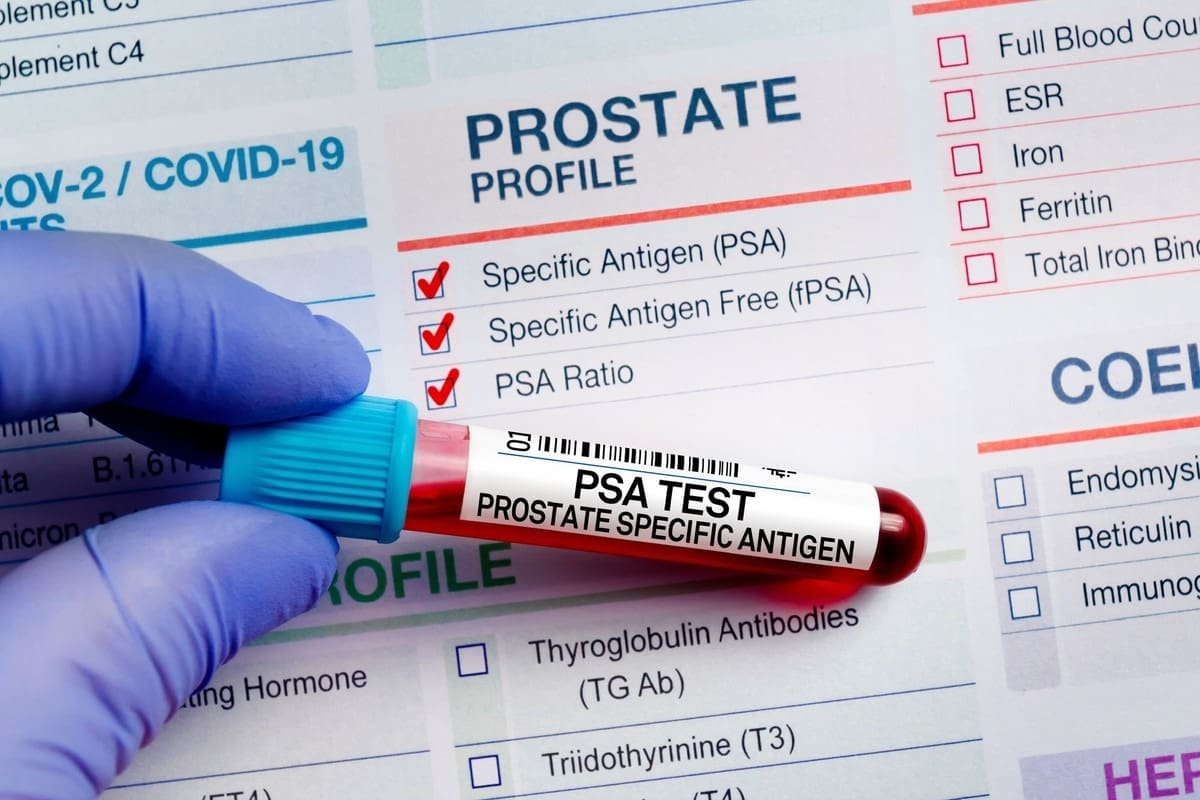Last Updated on November 27, 2025 by Bilal Hasdemir

Choosing the right imaging test is key when diagnosing health issues. At LivHospital, we know how important it is to pick the best test for you. The right test can lead to the right diagnosis.
Diagnostic imaging methods like CT scans and MRIs differ mainly in technology. CT scans use X-rays, while MRIs use magnetic fields and radio waves. This difference affects how they’re used and the info they give.
Key Takeaways
- CT scans use X-rays, while MRIs use magnetic fields and radio waves.
- CT scans are generally quicker and less expensive.
- MRIs provide more detailed images, which is good for certain diseases.
- The choice between CT and MRI depends on the specific condition being diagnosed.
- Understanding the differences between CT scans and MRIs is essential for accurate diagnosis.
Understanding Medical Imaging Technologies

It’s important to know how medical imaging works to see the difference between CT scans and MRIs. These technologies are key in healthcare today. They help doctors find and treat many health issues.
The Evolution of Diagnostic Imaging
Diagnostic imaging has changed a lot, starting with Wilhelm Conrad Röntgen’s discovery of X-rays in 1895. CT scans and MRIs are big steps forward. CT scans use X-rays to show body parts in detail. MRIs use magnetic fields and radio waves for internal images.
These technologies have improved a lot. This is thanks to better computers, detectors, and our knowledge of magnetic resonance. Now, CT scans and MRIs are vital in medicine. They offer unique benefits for diagnosing.
The Importance of Choosing the Right Imaging Method
Deciding between a CT scan and an MRI depends on several things. These include the health issue, the body part, and the patient’s health. CT scans are good for quick checks in emergencies, like finding bleeding or injuries. MRIs are better for soft tissue images, like the brain, spinal cord, and joints.
- Key considerations include the type of tissue being imaged, the need for contrast agents, and the patient’s medical history.
- The choice between CT scans and MRIs also depends on the specific diagnostic question being addressed.
Knowing the strengths and limits of each helps doctors make better choices. This leads to more accurate diagnoses and better treatment plans.
CT Scan: Technology and Mechanism

CT scans are a big step forward in medical imaging. They use X-rays to make detailed pictures of the body’s inside. These pictures help us find and understand many health problems.
How CT Scans Work Using X-ray Technology
A CT scan uses X-rays to take pictures of the body from different sides. The X-ray machine moves around the body, taking data. A computer then makes detailed images from this data.
This technology works because different parts of the body absorb X-rays differently. By measuring these differences, we can see inside the body. This helps us spot injuries, cancers, and other diseases.
The CT Scanning Process and Equipment
The CT scan process starts with the patient lying on a table that slides into a big machine. The machine moves around the patient, taking X-ray pictures from all sides. It’s all done very quickly, in just a few minutes.
Today’s CT scanners are faster and make clearer pictures. They have new tech like spiral scanning. This lets them scan without stopping, making it better for big scans or for people who can’t hold their breath.
Types of CT Scans and Their Applications
There are many kinds of CT scans, each for different uses. Here are a few:
- Standard CT Scan: Good for general checks, like finding injuries or diseases in organs and tissues.
- High-Resolution CT Scan: Makes very detailed pictures of small things, like the lungs and inner ear.
- Spiral CT Scan: Scans continuously, great for big areas or for people who can’t hold their breath.
- CT Angiography: Uses dye to see blood vessels and find vascular problems.
Knowing about these CT scans helps us pick the right one for each patient. This makes sure they get the best care.
MRI: Technology and Mechanism
Magnetic Resonance Imaging (MRI) is a top-notch tool for doctors. It uses strong magnetic fields and radio waves to show the body’s inside parts. Unlike others, MRI shows soft tissues well without harmful radiation. This makes it key in many medical fields.
Using Magnetic Fields and Radio Waves
MRIs align hydrogen nuclei in the body with a strong magnetic field. Then, radio waves disturb these nuclei, causing them to send signals. The MRI machine catches these signals to make detailed images.
The process involves several key components:
- A strong magnetic field to align the hydrogen nuclei.
- Radiofrequency pulses to disturb the nuclei and generate signals.
- Coils to receive the signals emitted by the nuclei.
- Advanced computer algorithms to reconstruct the images.
The MRI Scanning Process and Equipment
The scanning starts with the patient in the MRI machine, a big, cylindrical tube. The machine makes a strong magnetic field and radio waves. Scans can last from 15 to 90 minutes, based on the scan type and area.
The MRI equipment is highly sophisticated, with different types of machines available for various applications.
Types of MRI Scans and Their Applications
There are many MRI scans, each for different uses. These include:
- Functional MRI (fMRI) for assessing brain activity.
- Magnetic Resonance Angiography (MRA) for imaging blood vessels.
- Magnetic Resonance Venography (MRV) for imaging veins.
- Diffusion-weighted imaging for detecting stroke and other conditions.
Each MRI scan type offers special info for doctors. This helps them diagnose and manage many health issues.
CT vs MRI: Key Technological Differences
CT scans and MRIs differ in more than just their uses. Their technology is what sets them apart. Knowing these differences helps us see their strengths and weaknesses in medical imaging.
Radiation vs Non-Ionizing Technology
CT scans and MRIs use different technologies. CT scans use X-rays, a type of ionizing radiation. This is good for seeing dense things like bones but raises concerns about radiation. MRIs, on the other hand, use magnetic fields and radio waves. This makes them safer for soft tissue and for people who need many scans without worrying about radiation.
Image Resolution and Tissue Contrast
The technology behind each modality affects what they can image best. MRIs are known for their clear images of soft tissues. This makes them great for diagnosing issues with organs and soft tissues. CT scans are better for bones and lungs but can also show soft tissues well, thanks to contrast agents. Yet, they can’t match MRI’s soft tissue detail.
Scanning Time and Patient Requirements
Scanning time and patient needs are also different. CT scans are faster, usually taking just a few minutes. This is a big plus in emergencies. MRIs, though, can take longer, sometimes up to an hour. They also need patients to stay very quiet and in a small space, which can be hard for those with claustrophobia.
Are CT Scans and MRIs Ever Interchangeable?
While both CT scans and MRIs are used for imaging, they’re not always the same. The choice depends on what’s being looked at, the clinical question, and the patient’s needs. For example, CT scans are often used in emergency trauma situations because they’re quick and good for seeing bones and internal injuries. MRIs, on the other hand, are better for detailed soft tissue checks, like in neurological or joint injuries.
In summary, the technology behind CT scans and MRIs defines their roles in medical imaging. Understanding these differences helps doctors choose the right tool for each patient, improving care.
Clinical Applications of CT Scans
CT scans have many uses in medicine. They help in emergencies and in finding cancer. They are fast, accurate, and show detailed images of the body.
Emergency and Trauma Assessment
In emergency care, CT scans are key. They quickly check for severe injuries or acute conditions. CT scans for emergency cases are great for spotting internal injuries or bleeding.
For example, they can find brain injuries fast. This helps doctors make quick decisions.
Bone Fractures and Skeletal Imaging
CT scans are also good for checking bone fractures. They show bone details, helping doctors plan treatments.
They can also measure bone density. This helps in diagnosing and managing osteoporosis.
Cancer Detection and Staging
CT scans are vital in cancer care. They help find tumors and see how big they are. They also check if cancer has spread.
This info is key for making treatment plans. Plans might include surgery, chemo, or radiation.
Internal Bleeding and Vascular Conditions
CT scans also help with vascular issues. They spot bleeding, aneurysms, and other problems. This allows for quick treatment.
| Clinical Application | Benefits of CT Scans |
| Emergency and Trauma Assessment | Rapid diagnosis of life-threatening conditions |
| Bone Fractures and Skeletal Imaging | Detailed imaging of bone structures for accurate diagnosis |
| Cancer Detection and Staging | Identification of tumors and assessment of cancer spread |
| Internal Bleeding and Vascular Conditions | Detection of bleeding sites and vascular abnormalities |
It’s important to know the difference between an MRI and CT scan. CT scans are often chosen in emergencies because they are quick and easy to get.
Clinical Applications of MRIs
We use MRI scans to find and track many medical issues. This includes neurological problems and muscle injuries. MRI gives us a closer look at organs and soft tissues.
Neurological Disorders and Brain Imaging
MRI is key for neurological imaging. It lets us see the brain’s details. It helps find stroke, multiple sclerosis, and brain tumors.
Its high detail helps doctors spot small changes in the brain. This is vital for early treatment.
Soft Tissue Evaluation and Organ Assessment
MRI shows soft tissues clearly. It’s great for looking at organs like the liver, kidneys, and heart. It also checks soft tissue injuries, like ligaments and tendons.
This is super helpful in sports medicine. It helps diagnose and manage injuries.
Joint and Musculoskeletal Conditions
MRI is great for musculoskeletal conditions. It helps see how bad joint damage is. This is key for planning treatments or surgery.
Spinal Cord and Nerve Imaging
MRI is also key for the spinal cord and nerves. It finds issues like herniated discs, spinal stenosis, and nerve compression. MRI’s detailed images help doctors plan treatments accurately.
Patient Experience and Preparation
Looking into CT scans and MRIs, we must think about the patient’s view. Being ready for these tests can make the experience better. That’s why knowing how to prepare is key.
Preparing for a CT Scan
Getting ready for a CT scan is simple. You might need to skip eating or drinking a few hours before. Wear comfy clothes and take off any metal items or jewelry.
Preparing for an MRI
For an MRI, tell your tech about any implants. Remove all metal things, like jewelry and glasses. Knowing this can make you feel less anxious.
Claustrophobia and Anxiety Management
If you’re worried about a CT scan or MRI, there are ways to feel better. Some places have open MRI machines or sedation. Try breathing exercises and talk to the staff to ease your worries.
Contrast Agents and Their Uses
Contrast agents make images clearer on CT scans and MRIs. CT scans use iodine, while MRIs use gadolinium. They help doctors see better. Knowing about them can help you get ready for your test.
Comparing Cost, Accessibility, and Speed
When we look at CT scans and MRIs, we see different strengths and weaknesses. These differences affect how much they cost, how easy they are to get, and how long they take. These factors help decide which test is best for patients and doctors.
Financial Considerations and Insurance Coverage
CT scans are usually cheaper than MRIs. A CT scan in the U.S. can cost between $300 and $6,750. MRI prices range from $400 to $12,000 or more. Most insurance plans cover both tests when they’re needed.
Key financial considerations include:
- The cost of the scanning procedure itself
- Fees for radiologist interpretation
- Additional costs for contrast agents if used
Availability of Equipment and Wait Times
CT scanners are more common than MRI machines, which is good for emergencies. This means patients can often get CT scans faster. MRI wait times are longer because they’re in higher demand for some tests.
Accessibility is influenced by:
- The number of scanning machines available in a given area
- The type of healthcare facility (specialized vs. general)
- Urgent vs. non-urgent scheduling priorities
Duration of Procedures and Results Turnaround
CT scans are quicker than MRIs. A CT scan takes just a few minutes. MRIs can take 15 to 90 minutes. CT scans are better for emergencies or when patients can’t stay in one place for long.
Recent Technological Advancements
New technology has made CT and MRI scans better. CT scans now scan faster and show clearer images. MRIs have also improved, with newer machines scanning quicker and showing better images.
Recent advancements include:
- Improved scanner technology for faster and clearer images
- Advanced software for better image reconstruction and analysis
- Increased availability of high-field MRI machines
Conclusion: Making the Right Choice Between CT and MRI
Choosing between a CT scan and an MRI can be tough. Both have their own strengths and uses. It’s key to think about your medical issue and your doctor’s advice when deciding.
Your doctor will pick the best test for you. It’s good to ask questions and talk about any worries. Knowing the differences between CT scans and MRIs helps you make a smart choice.
The right choice between CT and MRI depends on many things. This includes the type of injury or condition, if contrast agents are needed, and what you personally need. Talking to your doctor and understanding both tests can help you get the right diagnosis and treatment.
FAQ
What is the main difference between a CT scan and an MRI?
CT scans use X-rays to create images. MRIs use magnetic fields and radio waves. This makes them different in how they show the body’s inside.
Are CT scans and MRIs used for the same medical conditions?
No, they’re not always for the same issues. CT scans are good for emergencies like internal injuries. MRIs are better for soft tissue, neurological, and musculoskeletal problems.
Is a CT scan or MRI more accurate for diagnosing certain conditions?
It depends on the condition. MRIs are better for soft tissue and neurological issues. CT scans are better for bone fractures and internal injuries.
Do CT scans and MRIs involve radiation?
CT scans use X-ray radiation. MRIs don’t use ionizing radiation. Instead, they use a magnetic field and radio waves.
How long do CT scans and MRIs typically take?
CT scans are quick, usually a few minutes. MRIs can take 15 to 90 minutes, depending on the scan’s complexity.
Can I undergo a CT scan or MRI if I have a medical implant or certain health conditions?
Some implants, like pacemakers, may not be safe for MRIs. Always tell your doctor about implants or health issues before a scan.
Are CT scans and MRIs covered by insurance?
Insurance coverage varies. Both are usually covered if needed. But, check with your provider for details.
How do I prepare for a CT scan or MRI?
Remove jewelry and wear loose clothes. You might need to use a contrast agent. Your doctor will give specific instructions.
Can claustrophobia affect my ability to undergo an MRI?
Yes, claustrophobia is a concern for MRIs. Open MRI machines, sedation, or relaxation methods can help.
What are the benefits of using a contrast agent during a CT scan or MRI?
Contrast agents make certain tissues more visible. This improves the accuracy of both scans. The type of agent used is different for CT and MRI.
References:
- Florkow, M. C., et al. (2022). Magnetic Resonance Imaging Versus Computed Tomography in Orthopedic Care: A Systematic Review. Clinics in Orthopedic Surgery, 14(1), 19-32. https://pmc.ncbi.nlm.nih.gov/articles/PMC9305220/






